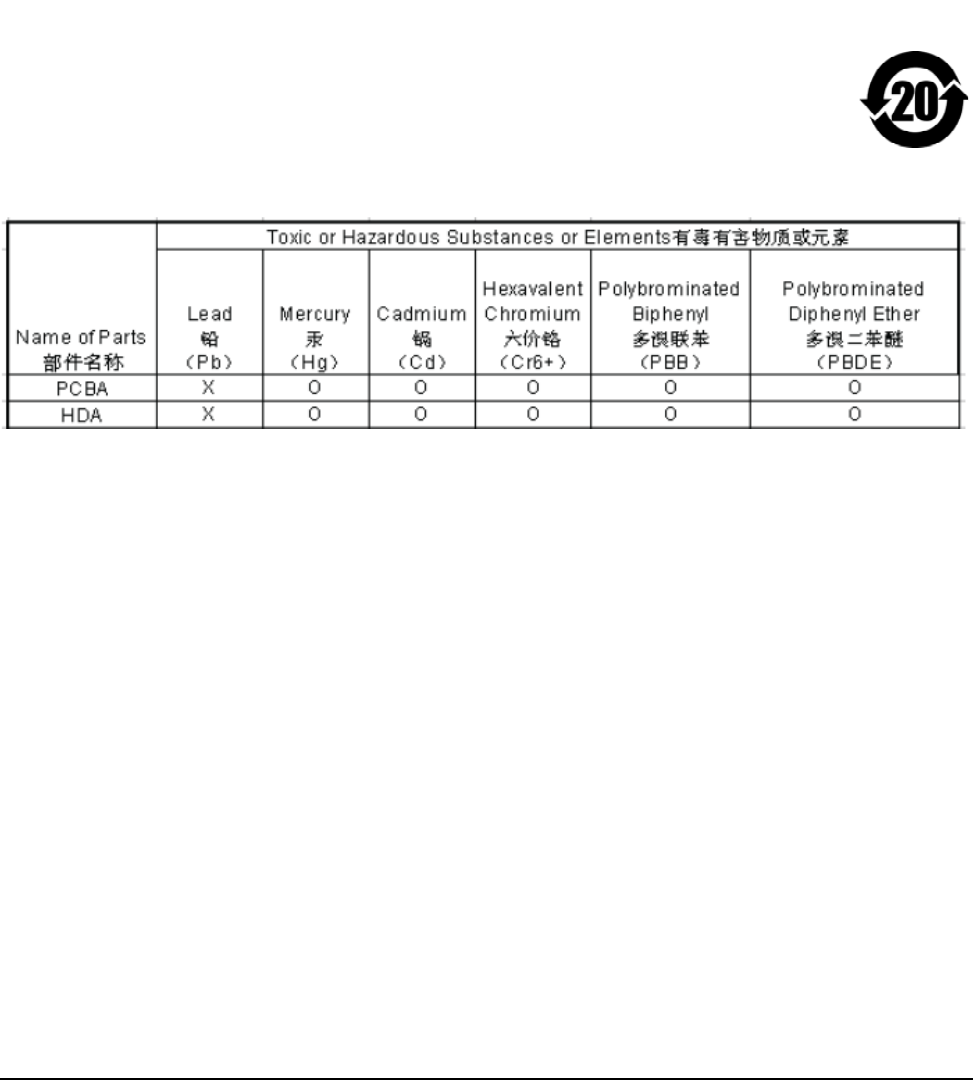Computer Drive User Manual
Table Of Contents
- 1.0 Introduction 1
- 2.0 Drive specifications 3
- 2.1 Formatted capacity 8
- 2.2 Default logical geometry 8
- 2.3 Recording and interface technology 8
- 2.4 Physical characteristics 9
- 2.5 Seek time 9
- 2.6 Start/stop times 10
- 2.7 Power specifications 10
- 2.8 Environmental specifications 14
- 2.9 Acoustics 16
- 2.10 Electromagnetic immunity 16
- 2.11 Reliability 17
- 2.12 Agency certification 17
- 2.13 Environmental protection 19
- 2.14 Corrosive environment 19
- 3.0 Configuring and mounting the drive 21
- 4.0 Serial ATA (SATA) interface 25
- 5.0 Seagate Technology support services 35
- Figure 1. Typical 5V startup and operation current profile 12
- Figure 2. Typical 12V startup and operation current profile 12
- Figure 3. Serial ATA connectors 22
- Figure 4. Attaching SATA cabling 22
- Figure 5. Mounting dimensions (1000 GB models) 23
- Figure 6. Mounting dimensions (320 and 160 GB models) 24
- 1.0 Introduction
- 2.0 Drive specifications
- 2.1 Formatted capacity
- 2.2 Default logical geometry
- 2.3 Recording and interface technology
- 2.4 Physical characteristics
- 2.5 Seek time
- 2.6 Start/stop times
- 2.7 Power specifications
- 2.8 Environmental specifications
- 2.9 Acoustics
- 2.10 Electromagnetic immunity
- 2.11 Reliability
- 2.12 Agency certification
- 2.13 Environmental protection
- 2.14 Corrosive environment
- 3.0 Configuring and mounting the drive
- 4.0 Serial ATA (SATA) interface
- 5.0 Seagate Technology support services
- Index

DiamondMax 22 Serial ATA Product Manual, Rev. A 19
2.13 Environmental protection
Seagate designs its products to meet environmental protection requirements worldwide, including regulations
restricting certain chemical substances.
2.13.1 European Union Restriction of Hazardous Substances (RoHS) Directive
Seagate designs its products to meet environmental protection requirements worldwide, including regulations
restricting certain chemical substances. A new law, the European Union Restriction of Hazardous Substances
(RoHS) Directive, restricts the presence of chemical substances, including Lead, Cadmium, Mercury,
Hexavalent Chromium, PBB and PBDE, in electronic products, effective July 2006. This drive is manufactured
with components and materials that comply with the RoHS Directive.
2.13.2 China Restriction of Hazardous Substances (RoHS) Directive
2.14 Corrosive environment
Seagate electronic drive components pass accelerated corrosion testing equivalent to 10 years exposure to
light industrial environments containing sulfurous gases, chlorine and nitric oxide, classes G and H per ASTM
B845. However, this accelerated testing cannot duplicate every potential application environment. Users
should use caution exposing any electronic components to uncontrolled chemical pollutants and corrosive
chemicals as electronic drive component reliability can be affected by the installation environment. The silver,
copper, nickel and gold films used in Seagate products are especially sensitive to the presence of sulfide, chlo-
ride, and nitrate contaminants. Sulfur is found to be the most damaging. In addition, electronic components
should never be exposed to condensing water on the surface of the printed circuit board assembly (PCBA) or
exposed to an ambient relative humidity greater than 95%. Materials used in cabinet fabrication, such as vulca-
nized rubber, that can outgas corrosive compounds should be minimized or eliminated. The useful life of any
electronic equipment may be extended by replacing materials near circuitry with sulfide-free alternatives.
2.13.2
Ё䰤ࠊॅ䰽⠽કⱘᣛҸ
This product has an Environmental Protection Use Period (EPUP) of 20 years. The following
table contains information mandated by China's "Marking Requirements for Control of
Pollution Caused by Electronic Information Products" Standard.
䆹ѻક᳝ᑈⱘ⦃๗ֱᡸՓ⫼਼ᳳ˄(383DŽϟ㸼ࣙњЁĀ⬉ᄤѻક᠔ᇐ㟈ⱘ∵ᶧ
ⱘࠊⱘ䆄ো㽕∖ā᠔ᣛᅮⱘֵᙃ
DŽ
"O" indicates the hazardous and toxic substance content of the part (at the homogenous material level) is
lower than the threshold defined by the China RoHS MCV Standard.
“
O”
㸼⼎䆹䚼ӊ˄Ѣৠ㉏⠽કᑺϞ˅᠔ⱘॅ䰽᳝↦⠽䋼ԢѢЁ
RoHS MCV
ᷛޚ᠔ᅮНⱘ䮼ᾯؐDŽ
"X" indicates the hazardous and toxic substance content of the part (at the homogenous material level)
is over the threshold defined by the China RoHS MCV Standard.
“X”
㸼⼎䆹䚼ӊ˄Ѣৠ㉏⠽કᑺϞ˅᠔ⱘॅ䰽᳝↦⠽䋼䍙ߎЁ
RoHS MCV
ᷛޚ᠔ᅮНⱘ䮼ᾯؐDŽ










